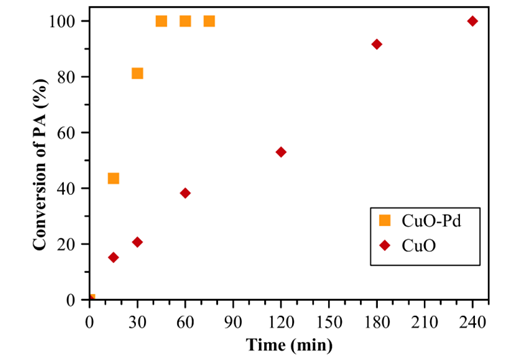Advantages
- Solar-driven visible-light catalysis eliminates high-temperature fossil fuel dependence
- Rapid phenylacetylene conversion yields 100% within 45 minutes (CuO–Pd)
- Employs earth-abundant copper oxide reducing overall catalyst costs
- Scalable heterogeneous system offers high selectivity, facile recyclability
Summary
Traditional carbon–carbon (C–C) coupling reactions underpin the synthesis of pharmaceuticals, agrochemicals, and advanced materials but remain locked in energy-intensive, high-temperature processes driven by fossil fuels. These thermal methods consume vast amounts of non-renewable energy, emit substantial greenhouse gases, and resist integration with renewable electricity or solar inputs, posing a major barrier to decarbonizing the chemical sector.
Our innovation replaces conventional thermal catalysts with CuO-based nanoparticles and CuO–Pd hybrids that harness visible light (300–2000 nm) to drive oxidative C–C coupling at ambient conditions. By embedding Pd within the CuO framework, we achieve 100% conversion of phenylacetylene to diphenyl diacetylene in just 45 minutes (with base) and 2 hours base-free, outperforming bare CuO (240 minutes with base, >10 hours without) while maintaining exclusive product selectivity. This heterogeneous, scalable system leverages earth-abundant materials for cost efficiency, seamlessly integrates with solar or LED light sources, and enables rapid, recyclable photocatalysis—transforming sustainable chemical manufacturing.

Conversion versus reaction time observed for oxidative C-C coupling of PA into DPDA under visible light illumination using CuO-Pd hybrid nanostructures and CuO nanostructures in the presence of Base.
Desired Partnerships
- License
- Sponsored Research
- Co-Development